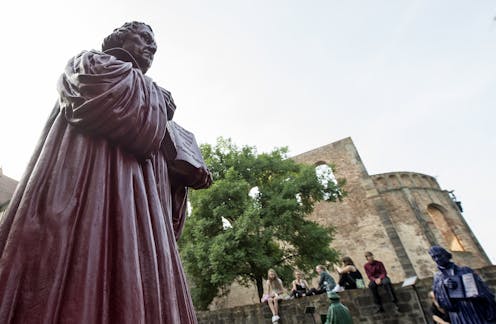The lasting impact of Luther's Reformation: 4 essential reads
On Oct. 31, 1517, a German monk, Martin Luther, started the Protestant Reformation. Its impact went far beyond the split in the Church that most people are familiar with.

It was over 500 years ago, on Oct. 31, 1517, that a German monk, Martin Luther, initiated a split in the Roman Catholic Church leading to the Protestant Reformation.
In his “95 Theses,” nailed to Germany’s Castle Church in Wittenberg, Luther challenged the practice of selling papal indulgences that promised individuals absolution from their sins and a way into heaven. In doing so, Luther questioned the overall authority of the Church.
Scholars writing for The Conversation have analyzed the lasting impact of the moment, including Christianity’s division into Protestantism and Catholicism. Here are four essential reads.
1. The spiritual virtuoso
One question that scholars have often asked is how a single document managed to trigger such a dramatic change.
University of Oregon’s Marion Goldman and historian Steve Pfaff, explain that when Luther posted his theses, at the age of 34, he was an ordained priest and a biblical theology scholar at University of Wittenberg. His personal life and spiritual practice played a key role in drawing “enthusiastic support from ordinary people,” they argue. Indeed, it was Luther’s students who first responded to his message that all Christians are created equal and could reach heaven based on their own faith.
In addition, Luther set an example through his own spiritual life as a monk of almost 20 years’ standing. As Goldman and Pfaff write, he continually tried to achieve spiritual perfection:
“Beginning his day at 3 a.m., Luther tried to purify himself through practices like fasting, confession, reading scriptures late into the night and silently praying at almost every moment. For penance, he fasted to the point of emaciation and would even strike himself with a whip.”
2. Spreading literacy
An important contribution that went beyond religion was how he helped bring people together under a common German language.
Indiana University’s Richard Gunderman writes that Luther “wanted ordinary people to assume more responsibility for reading the Bible.”
After he was branded an outlaw for refusing to recant his teachings, Luther took shelter in a castle. During his two years in hiding he translated the New Testament from Latin into German. He did this just a few years after the introduction of Gutenberg’s printing press, which made wide dissemination possible.
Gunderman explains that this translation of the Bible provided a “single German vernacular, helping to bring people together around a common tongue.”
Luther promoted the view that people would come closer to God, by reading the Bible on their own and provided Bible commentaries to help them make that direct encounter with the scripture. At the time, farming was the main vocation and most people did not know how to read. Gunderman adds,
“In promoting his point of view, Luther helped to provide one of the most effective arguments for universal literacy in the history of Western civilization.”
3. Priestly celibacy
Much like today, issues of mandatory priestly celibacy were a source of conflict among Christians in the 16th century. Scholar of early Christianity Kim Haines-Eitzen writes that priests faced accusations of sexual impropriety and corruption, which led to other reform movements in the 16th century.
In the divergent views that emerged, Luther was among those who argued that “allowing priests to marry would prevent cases of sexual immorality.” Haines-Eitzen explains how Luther drew upon Paul’s letters, the most influential apostle of the early Christian movement, for support of his views. In the earliest recorded discussion on celibacy, Paul says that for those who could not exercise self control, marriage was a better option.
4. Impact in America
Perhaps a little-known story is how some 400 years later, a small group of Americans would try to reunite Protestants and Catholics.
Religion historian David Mislin explains how Protestants in the U.S. – alarmed by the growing numbers of atheists and agnostics – committed itself to uniting Christianity so as to stop the spread of such ideas.
He writes about a noted theologian, Newman Smyth, who declared that “a Christianity divided in its own house against itself” could not survive. The group, of course, did not succeed in its efforts.
But as Mislin concludes,
“In fact, the main unintended consequence of the unity campaign was that it caused people to realize that they did not want actual unity. It was possible, in other words, to accept the post-Reformation division of Christianity. The differences separating the Protestants and Catholics could be shrugged off as ‘peculiarities’ rather than intolerable divisions.”
Read These Next
TikTok fears point to larger problem: Poor media literacy in the social media age
If the US wants to protect young people from misinformation and foreign influence, focusing on TikTok…
Are tomorrow’s engineers ready to face AI’s ethical challenges?
Ethics is often neglected in engineering education, two researchers write, despite mounting questions…


